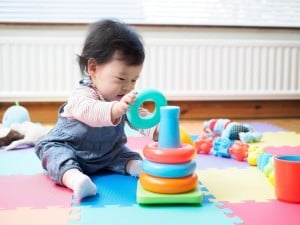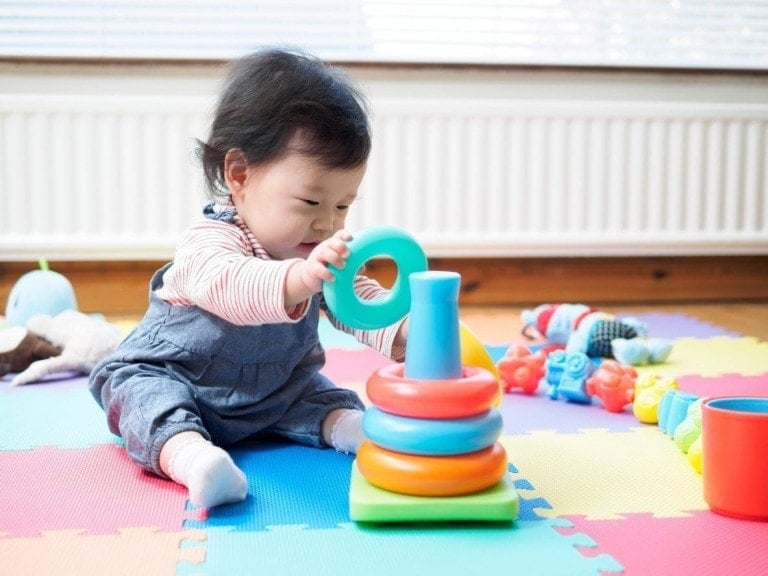Unfortunately, it’s a fact of life: babies cry. Because they can’t yet speak, crying is their primary form of communication with their caregivers, and we have to figure out what is and isn’t normal baby fussiness. When infants are cold, hungry, tired, or need a diaper change, their only way to tell you what they need is to fuss. As a new parent, it can be challenging to differentiate between types of cries and decipher what your baby needs. It’s frustrating and overwhelming when you feel like you’ve tried everything to console them, and they’re still fussing throughout the day. You want to solve their discomfort but may also need a break from the noise!
If you’re a new parent, you may be wondering if your baby’s fussiness is within the realm of normal. While there’s a wide range of typical infant fussiness, here’s a guide to knowing the difference between typical baby fussiness and when to seek further care.
Normal Baby Fussiness
Babies cry — a lot! Even happy, healthy babies cry. Healthy infants typically follow a crying curve, gradually increasing from birth until 5 to 6 weeks old. Fussiness may peak or plateau at this point until crying typically begins to decline around 3 months of age.1
It may seem like an infant should only cry for a specific reason, and if you could just find that reason, you could stop the crying! But that’s not always the case, as babies can also cry for other reasons we can’t guess. Let’s take a look at some ways to help determine if your baby’s fussiness is typical:
Possible Reasons for Normal Crying
Crying for a predictable reason is almost always typical baby fussiness. Again, this is their primary way to communicate. If they stop crying after you remedy the source of their discomfort, this crying is very likely to be normal. Some common reasons include being tired, hungry, hot, cold, overfull, bored, lonely, or having a wet diaper.2,9
In other instances, there is a cause, but you may be unable to identify or quickly rectify it. For example, one less obvious source of fussing is overstimulation.10,11 Just as we can get overstimulated by their crying, our babies can get overstimulated by our typical environments.11 They may need the opportunity for a reset in a low-stimulation setting.4,5,10,11 (I sometimes had success rocking my swaddled newborn daughter in a dark room with quiet white noise to settle her during a crying episode.) Imagine being in a relatively quiet, comfortable, warm place for 9 months and suddenly finding yourself in a very loud and cold location. It would be a shock to anyone!
Unexplained Crying Can Also Be Normal
It can also be common to have “unexplained crying.” One to two hours total of unexplained crying throughout the day is to be expected.2 When considering whether unexplained crying is normal, it’s essential to note if the baby is otherwise happy when they aren’t crying. If your baby is consolable and content between periods of crying, their fussing is likely within the normal range.2
Abnormal Baby Fussiness
Some professionals define excessive crying as “colic,” which is “frequent, prolonged and intense crying or fussiness in a healthy infant,” according to the Mayo Clinic.3 Excessive crying affects between 5% and 40% of infants globally and accounts for 10-20% of pediatrician visits in early infancy.4,12 Colic usually starts to present itself by week three.13 Just as normal infant crying increases in the early weeks and peaks around week six, excessive crying or colic also often peaks around week six.2,3,4 The condition usually resolves on its own between three and four months.3
Sleep-deprived new parents may have shorter fuses, and in this state, it can be easy to think that an average level of infant fussiness is abnormal.15 So, how do you know if your baby’s fussiness is above the standard crying curve? Below are some characteristics of colic to consider:
1. Their Crying Falls Under Wessel’s “Rule of 3’s”
The original criteria for a colic diagnosis fell under what’s known as Wessel’s “Rule of 3’s” and were as follows:1,4,5
- Crying for more than three hours per day
- On at least three days per week
- For three weeks or more
While this can be a good starting point for identifying whether your baby’s fussiness is excessive, the medical field has started to account for not only the amount of crying but also the character of that crying.1
2. Your Baby Is Unsoothable
Even in typical fussiness, it may take some time to figure out why your baby is crying and how to make them feel better. However, most often, you’ll be able to soothe them eventually (or they may soothe themselves!). If you would classify your infant’s fussiness as often unsoothable and prolonged, this may be outside the normal range.3,4,5,16
3. They Have Mysterious Distress
Sometimes not being able to identify the cause of your baby’s crying can be expected. But if their crying is often or always a mystery, this may be abnormal.5 If you’d describe excessive crying as a part of your baby’s character, their level of fussiness may be abnormal.
4. Baby Is Otherwise Healthy
For you to classify infant fussiness as abnormal, there can’t be an obvious or apparent cause for the crying in a child under 5 months old when the symptoms start and stop.4 For instance, the baby must not have a fever, blood in the stool, or other known or obvious illness. They must also be eating and growing appropriately and demonstrating no evidence of failure to thrive.2,4
Solutions to Baby Fussiness
If you’ve identified that your baby’s fussiness isn’t typical, you may wonder what to do about it. Unacknowledged colic is associated with higher rates of maternal postpartum depression and shaken baby syndrome, so addressing it can help protect you and your baby.4 Your medical provider or baby’s pediatrician may be able to counsel and educate you on treatments, interventions, and coping strategies. Below are some resources and interventions to consider if you think your baby may be suffering from excessive crying:
1. Talk to Your Pediatrician
There isn’t always a medical reason or cause for abnormal crying. However, if you feel your baby is crying above the average amount, reach out to their pediatrician for a visit. They’ll take a medical history and physical examination to ensure no underlying medical cause for the fussiness. Without alarming symptoms, your pediatrician may review some of the therapies below for excessive crying.
2. Try Behavioral Intervention
Some parents report success with different behavioral interventions. Some things that can potentially help include:2,4
- Infant swings
- Car rides
- Pacifiers
- White noise
- Low-stimulation environments
- Increased holding and snuggling
Although none are guaranteed to improve crying, most can’t hurt to try! Just be sure to discuss any behavioral interventions with your pediatrician to ensure safety.
3. Make Dietary Changes
Diet or feeding changes aren’t typically recommended as a treatment for extreme fussiness, particularly for formula-fed infants.6 If there’s a family history of allergy, some doctors may recommend a brief trial of a hypoallergenic, hydrolyzed formula to treat excessive infantile crying. A review of studies showed a possible positive effect on breastfed infants’ crying by eliminating allergens from the mother’s diet.8 However, this can be difficult for the mother. Your doctor should encourage continued breastfeeding over maternal dietary changes (in the absence of bloody stools or other explicit symptoms of food allergy or intolerance in the infant).17
4. Explore Pharmacological Options
If you’re dealing with a fussy infant, family or friends may have suggested trying gripe water or simethicone drops. While these are generally safe to try, no benefits have been shown for crying babiesgripe water comes in many different formulations, so you have to ensure there aren’t potentially harmful ingredients.6 Other medications have been used to treat colic in the past, such as dicyclomine and cimetropium, but these aren’t recommended due to the potential for life-threatening effects such as sleepiness or apnea.6
Several studies have also looked at colic treatment with a specific probiotic strain: “lactobacillus reuteri.” They show some promising results, but research is still underway, and the efficacy of this intervention is far from guaranteed. Still, this option could be worth exploring with your pediatrician.7
5. Consider Alternative Therapies
Some people have reported success with decreasing infant crying by using herbal teas and other herbal remedies. However, experts need to do more research to examine side effects, standardize dosages, and ensure that consumption doesn’t interfere with a hunger for milk.6 In addition, there are some potentially toxic herbal remedies, so it’s better to avoid these.
Although chiropractic care hasn’t demonstrated a benefit over placebo in studies, some parents anecdotally report success with this treatment for their fussy infants.6 (Out of desperation, a friend of mine sought chiropractic care three times per week for her fussy and inconsolable 6-week-old. She noticed more regular and frequent bowel movements and a happier and calmer demeanor in her little one.)
The Good News About Abnormal Fussiness
While excessive crying is undoubtedly tough on you and your baby, there are a couple of positives to keep in mind about abnormal fussiness:
1. It’s Self-Limiting and Self-Resolving
Even without any intervention or treatment, excessive fussiness will go away on its own.3,4 No matter what, there’s an end in sight. However, this doesn’t mean you should suffer in silence, wait it out, or accept your fate as the parent of a colicky baby. After all, making it through four months of excessive crying can feel like an eternity while you’re living it.
2. It’s Benign
It may be a relief to know infant fussiness and excessive crying don’t always indicate that something severe is wrong. In addition, one study found that colicky babies showed no difference in temperament by toddlerhood compared to unaffected infants.14 Parents of babies who cry excessively also show no long-term anxious or depressive symptoms once the fussing has resolved.6
Remember: You’re Not Alone
Life with any newborn is tough. Your world has just been flipped upside down! While recovering from the physical trauma of birth, you’re now responsible for an entirely dependent baby. You’re adjusting to your new life and learning each other’s cues. With very little sleep, any amount of crying can set you over the edge. And with a new, fussy baby, it can feel like there’s no escape. But remember that you’re not alone! One review suggests that anywhere from 3% to 28% of infants suffer from colic.1
It will end, but until it does, be sure to take care of yourself. If possible, get help caring for your baby so you can take breaks when you feel overwhelmed. You can always reach out to your pediatrician if you’re concerned that something isn’t right with your little one, or contact your doctor if you need mental health resources. This is a phase, and it will pass!



































